Life As a Metal Pourer or Caster
Metal Pourer or Caster Example Operate hand-controlled mechanisms to pour and regulate the flow of molten metal into molds to produce castings or ingots.
List of Metal Pourer or Caster Job Duties
- Skim slag or remove excess metal from ingots or equipment, using hand tools, strainers, rakes, or burners, collecting scrap for recycling.
- Assemble and embed cores in casting frames, using hand tools and equipment.
- Remove solidified steel or slag from pouring nozzles, using long bars or oxygen burners.
- Stencil identifying information on ingots and pigs, using special hand tools.
- Examine molds to ensure they are clean, smooth, and properly coated.
- Add metal to molds to compensate for shrinkage.
Featured schools near , edit
Metal Pourer or Caster Required Skills
When polled, Metal Pourers and Casters say the following skills are most frequently used in their jobs:
Operation Monitoring: Watching gauges, dials, or other indicators to make sure a machine is working properly.
Operation and Control: Controlling operations of equipment or systems.
Active Listening: Giving full attention to what other people are saying, taking time to understand the points being made, asking questions as appropriate, and not interrupting at inappropriate times.
Critical Thinking: Using logic and reasoning to identify the strengths and weaknesses of alternative solutions, conclusions or approaches to problems.
Monitoring: Monitoring/Assessing performance of yourself, other individuals, or organizations to make improvements or take corrective action.
Coordination: Adjusting actions in relation to others’ actions.
Other Metal Pourer or Caster Job Titles
- Ingot Header
- Billet Header
- Steel Pourer
- Ladle Pourer
- Mold Maker
Is There Going to be Demand for Metal Pourers and Casters?
In 2016, there was an estimated number of 8,400 jobs in the United States for Metal Pourer or Caster. There is little to no growth in job opportunities for Metal Pourer or Caster. There will be an estimated 500 positions for Metal Pourer or Caster per year.
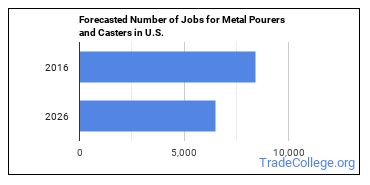
The states with the most job growth for Metal Pourer or Caster are Arkansas, Georgia, and Idaho. Watch out if you plan on working in Colorado, Minnesota, or New York. These states have the worst job growth for this type of profession.
Do Metal Pourers and Casters Make A Lot Of Money?
Metal Pourers and Casters make between $26,480 and $56,900 a year.
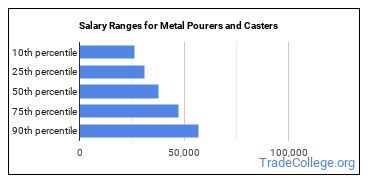
Metal Pourers and Casters who work in South Carolina, New York, or Alabama, make the highest salaries.
How much do Metal Pourers and Casters make in different U.S. states?
| State | Annual Mean Salary |
|---|---|
| Alabama | $46,530 |
| Arizona | $35,070 |
| Arkansas | $42,820 |
| California | $35,710 |
| Colorado | $37,760 |
| Georgia | $35,940 |
| Illinois | $47,760 |
| Indiana | $37,540 |
| Iowa | $39,880 |
| Kentucky | $43,340 |
| Massachusetts | $37,420 |
| Michigan | $41,220 |
| Minnesota | $35,450 |
| Mississippi | $37,560 |
| Missouri | $36,880 |
| New Jersey | $37,990 |
| New York | $46,420 |
| North Carolina | $43,590 |
| Ohio | $34,600 |
| Oregon | $41,340 |
| Pennsylvania | $39,570 |
| South Carolina | $49,420 |
| Tennessee | $42,790 |
| Texas | $40,160 |
| Washington | $38,450 |
| Wisconsin | $35,810 |
Tools & Technologies Used by Metal Pourers and Casters
Although they’re not necessarily needed for all jobs, the following technologies are used by many Metal Pourers and Casters:
- Microsoft Excel
- Microsoft Word
- Microsoft PowerPoint
- Microsoft Outlook
Becoming a Metal Pourer or Caster
Individuals working as a Metal Pourer or Caster have obtained the following education levels:
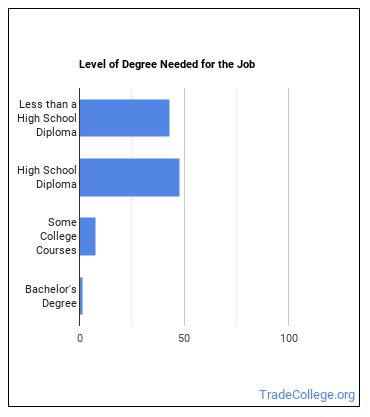
How many years of work experience do I need?

Where Metal Pourers and Casters Work
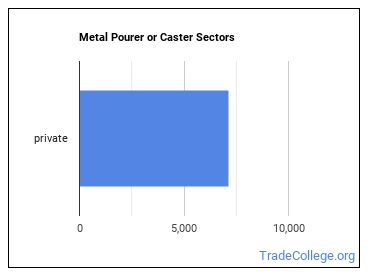
The table below shows the approximate number of Metal Pourers and Casters employed by various industries.
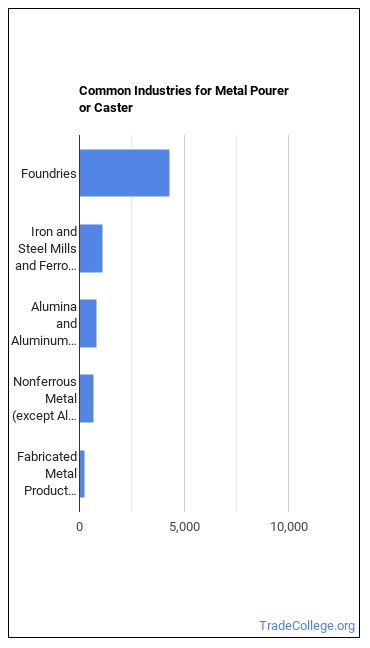
Other Jobs You May be Interested In
Those thinking about becoming a Metal Pourer or Caster might also be interested in the following careers:
- Farmworkers, Farm, Ranch, and Aquacultural Animals
- Foundry Mold and Coremakers
- Postal Service Mail Carriers
Career changers with experience as a Metal Pourer or Caster sometimes find work in one of the following fields:
References:
More about our data sources and methodologies.
Featured Schools
 Request Info
Request Info
|
Southern New Hampshire University You have goals. Southern New Hampshire University can help you get there. Whether you need a bachelor's degree to get into a career or want a master's degree to move up in your current career, SNHU has an online program for you. Find your degree from over 200 online programs. Learn More > |
